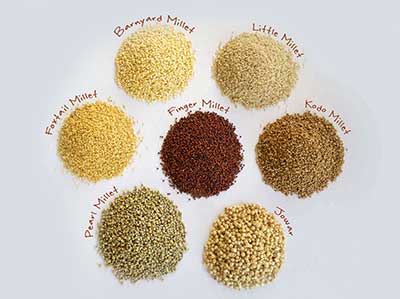GS-2: Issues relating to Poverty and Hunger.;
GS-3: Public Distribution System, issue of buffer stocks, Cropping Patterns in various parts of the country,
Key phrases- PDS, millets, MSP, nutria-cereals
Why in news-
UN declared 2023 as year of millets
Analysis:
What are millets?
- Millets are a group of small-seeded grasses, widely grown as cereal crops or grains for human food and as fodder
- India is the largest producer of millets in the world with a 41.0% global market share
- In 2018, India had proposed to celebrate 2023 as International Year of Millets at FAO
- Three major millet crops currently growing in India are jowar (sorghum), bajra (pearl millet) and ragi (finger millet)
Importance of millets
- Aid in fighting malnutrition as they are rich in rich in fiber, minerals, vitamins -Finger millet has 839% calcium content of wheat
- They are Gluten-free which is advantageous for people suffering from diabetes
- Millet crops sequester carbon from the atmosphere while paddy fields emit methane
-
Millets are less water intensive. E.g., One rice plant requires nearly 2.5 times the amount of water required by a single millet plant
- Millets are called ‘Famine reserves’ as they have a short growing season of 65 days and can keep well for two years or beyond.
Why is India losing on millet wealth?
- In the 1960s before the Green Revolution, millets were extensively grown and consumed in India. With the Green Revolution, the focus, rightly so, shifted to food security and high-yielding varieties of wheat and rice.
- Preference for Wheat in urban and now even rural areas due to better texture and changing food habits
- Lack of appropriate post-harvest processing technologies for small millets except finger millet
- With the intense marketing of processed foods, even the rural population started perceiving mill-processed rice and wheat as more aspirational.
- In rural India, the National Food Security Act of 2013 entitles three-fourths of all households to 5 kg of wheat or rice per person per month at Rs 2 and Rs 3 per kg, respectively, thus reducing the demand for millets.
- Scalable intervention in millet production, processing, and cross-border trade is yet to be observed
How is government fighting to revive millets?
- Millet Mission in 2018 as part of the National Food Security Mission - Promotion of technological interventions, improvement in seed quality
- First strategy from a consumption and trade point of view was to re-brand coarse cereals/millets as nutri-cereals
- From 2014-15 to 2020 MSPs for ragi has jumped by 113 per cent, by 72 per cent for bajra and by 71 per cent for jowar
- To provide a steady market for the produce, government included millets in the public distribution system
- Ministry of Women and Child Development has been working at the
intersection of agriculture and nutrition by –
- Setting up nutri-gardens,
- Promoting research on the inter linkages between crop diversity and dietary diversity
Way ahead
- Map the millets value chain, namely production, processing, distribution, consumption, and cross-border trades with the functions of agencies and actors involved in the value chain.
- Agricultural Technology Application Research Institutes and Krishi Vigyan Kendras can invest in capacity building of smallholder farmers through field demonstration
- Promote participatory millets farming, drawing best practices from Odisha, Chhattisgarh, and Karnataka. Agri-tech farms can be roped in to disseminate recommended practices to micro-entrepreneurs
- APEDA can incentivize commercial cultivation of millets such as ‘one district one product’ or cluster farming for trade promotion
- Generation of demand for millets-based products.2018 ‘#LetsMilletCampaign’ in Bengaluru promoted the use of millets in dishes such as risotto and pizza by restaurateurs. Food delivery startups such as FreshMenu rolled out millet-intensive menus
- Re-introduction of cultural associations and festivals that help promote the growth of millets. E.g., North-East Network in Nagaland organized in 2020, Mandukiya in Vishakhapatnam celebrated annually in June/July
Source: Business Line







